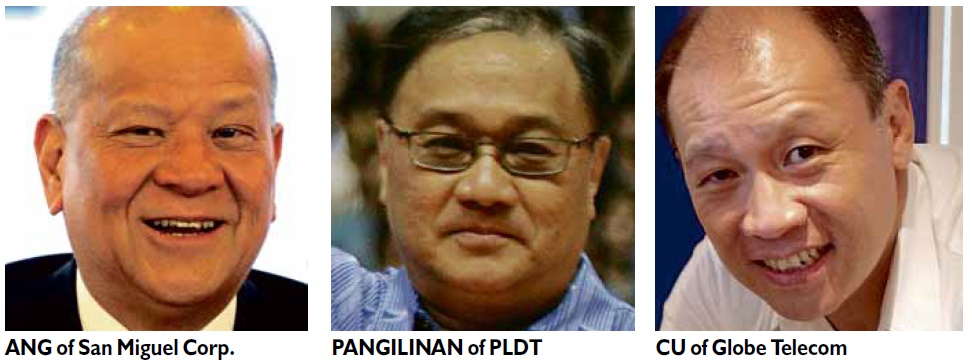SMC chief says P69-B telco sale a big sacrifice

Ramon S. Ang, SMC president and chief operating officer, said he expected PLDT and Globe to launch a “protracted legal battle” to slow down SMC’s telco startup which he felt would only delay the delivery of faster and cheaper internet access to mobile subscribers.
Ang issued a statement shortly after confirming SMC’s plan to unload its telco unit, including the prized 700-megahertz (MHz) broadband frequency.
On Monday, SMC signed a surprise deal to sell its telco unit to PLDT and Globe for P69.1 billion, just two months after partnership talks between SMC and Australian telco giant Telstra Corp. Ltd. collapsed.
PLDT and Globe, which made the acquisition via a 50-50 arrangement, wanted SMC’s coveted radio frequencies—the lifeblood of the telecommunications sector.
So valuable were the assets that a key feature of that deal was the return of some frequencies to the government, giving it the option to auction these off to another challenger to the duopoly.
As early as December last year, both PLDT and Globe had made known their plans to take the legal route to force SMC to share its spectrum (a high-quality frequency capable of traveling longer distances, requiring fewer cell towers and enjoying stronger indoor penetration).
Ang called it a “sacrifice sale” because the proposed P69.1-billion price tag for SMC’s telco business, held through Vega Telcom Inc., was “at cost,” or equivalent to the amount that SMC had spent in buying the rights and contractual obligations to obtain the frequency.
“This is a sacrifice we have to make to finally unlock the full potential of our high-quality, mobile broadband spectrum faster and allow consumers access to its benefits through the combined resources, network and expertise of the two carriers,” he said.
“Moving forward, we expect to fully recover what we have invested over the past six years building our network,” he added.
On Monday, PLDT chair/CEO Manuel V. Pangilinan and Globe CEO Ernest Cu said mobile internet services would start to improve starting three to six months from today.
However, they made no guarantee that prices would come down, with both of them saying these were “in line” with regional peers or were already “affordable.”
Cu noted that prices had already come down since the entry of the Gokongwei family’s Digital Telecommunications Philippines Inc., which operates Sun, over a decade ago.
“When Sun came in, the price of a phone call was P4.50 and P7.50 and a text was P1. Today, P25 buys you unlimited calling to our network and unlimited texting to other networks,” he said.
This environment of lower prices and massive capital spending—to keep pace with increasing demand for data services as smartphone penetration grows rapidly—was making it difficult for a new player to enter, Cu said.
Permitting bottlenecks in building new cell sites slows down expansion efforts, he said, noting that his company could build only about 500 cell sites a year.
Globe has between 6,000 and 7,000 cell sites, meaning a new player would need about 12 years “to catch up,” Cu said.
It was only 10 months ago when PLDT and Globe started worrying about losing their control of the lucrative telecom duopoly when Ang announced SMC’s much ballyhooed venture with Telstra and its promise of delivering cheaper and faster mobile and internet service to consumers.
When talks with Australia’s biggest internet and phone provider finally collapsed in March 2015, Ang still did not give up and instead looked for other telco partners, such as Telenor of Norway.
But after two months, he said he realized that splitting the spectrum between PLDT and Globe was “the most expeditious, feasible and in the best interest of the consumers, its stockholders and all the parties involved given the current situation.”
Ang said he finally realized that “obvious commercial and legal risks of pursuing the venture alone far outweighed the potential rewards for the company and its stakeholders.”
He said he remained steadfast in believing that bringing more players to the telco industry was the only way to bring down costs and increase download speed.
But he stressed that the time and resources SMC would use to create a formidable third player were better used for the company’s core strengths, such as power and infrastructure.
Ang said subscribers should not hold their breath. “Private [telco] companies will not come here anymore, believe me, they’re too scared,” he said on the sidelines of San Miguel Brewery Inc.’s annual meeting.
“Who can come in as a third player? Only the Philippine government,” Ang said. “When the Philippine government enters and they invite a foreign partner, no one will be scared anymore.”
He said a government agency could assume the role of a third telco player, citing the Department of Science and Technology as an example.
Ang said the key factor in his decision to drop his telco dream was the assurance of PLDT and Globe to implement SMC’s mobile broadband project faster” to deliver better, affordable services to consumers and enable the next wave of network upgrades for the carriers.”
